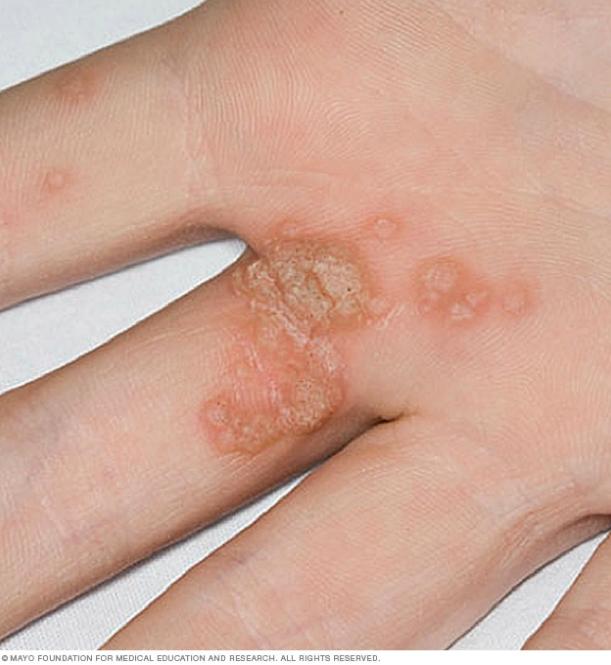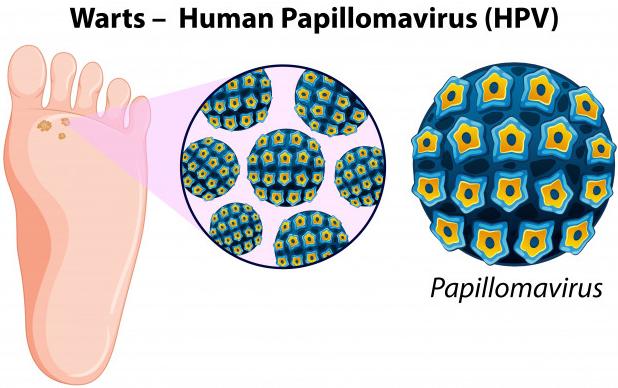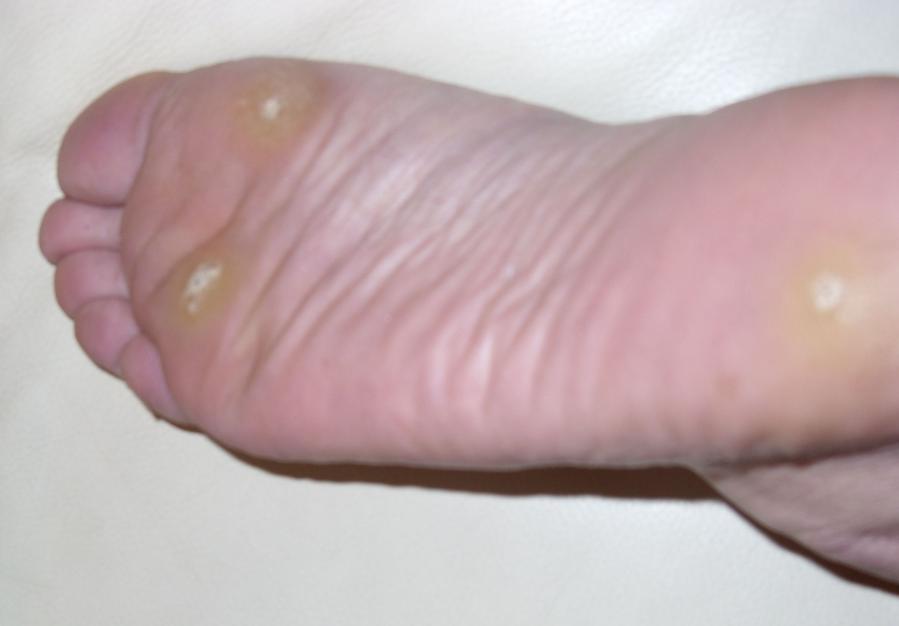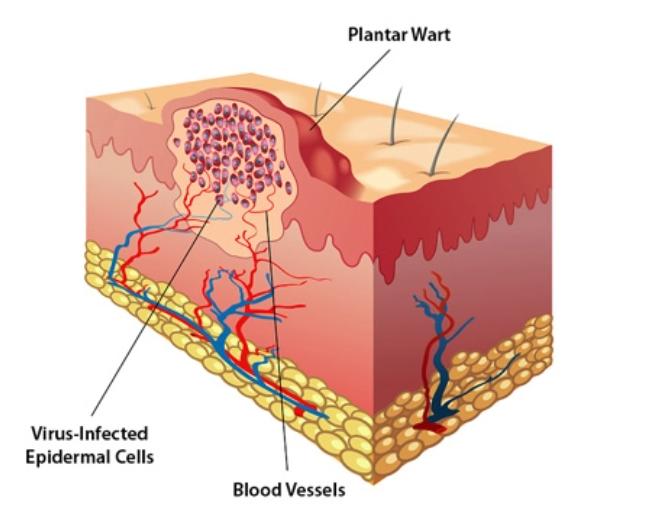Wart Treatment
What are warts?
Warts are a very prevalent skin disease and one of the most common reasons for patients to visit a dermatologist in NYC. There are many over-the-counter treatments for plantar warts and common warts. Most of the over-the-counter products are salicylic acid based. There are, however, many types of warts which do not respond to over-the-counter products and need a dermatologist to remove these warts. Warts can also occur in any area of the body, from flat warts on the face, to plantar warts on the soles of the feet, to periungual warts under the nail, to genital warts. These different warts need special treatment to be removed in these different anatomic locations on the body. Whether it be cryotherapy, fluorouracil, or cantharidin, Dr. Michele Green will advise you on the best treatment options for your warts. Dr. Green is trained to treat and remove these warts, safely, painlessly, and effectively, in her private NYC dermatology office.
What causes warts?
The common wart is a small, grainy growth, that feels rough to the touch. At the base of the common warts are small black dots, which are the small clotted blood vessels of the wart. Warts are very contagious and are spread from person to person via touch. The wart virus is highly contagious and is often seen in young children, young adults, and patents with weakened immune system. From the time of exposure, when someone touches you with a wart, it can take two to six months for you to develop a wart. This incubation period can vary if someone has a weakened immune system, which as those with HIV/AIDS or people who have had organ transplant. Individuals with atopic dermatitis or eczema, there the stratum corneum is disturbed, are more prone to warts and their spread. Since warts are so contagious, it is important to treat these at once to avoiding self spread and spreading to others.

The various types of human papillomavirus (HPV) cause warts. According to the American Academy of Dermatology of the more than 100 types of human papilloma virus, about 10 of which cause cutaneous skin warts. Different strains of human papillomavirus cause the different types of warts on the body. One type of human papillomavirus causes plantar warts while another type causes flat warts. There are a few types of HPV which can cause genital warts and a subset of these have been linked to cancers such as cervical cancer in women and penile cancer in men. The types of human papilloma virus which cause genital warts are different from the types of HPV which cause non-genital warts.
Everyone reacts differently to the wart virus. Whether you contract warts or not, or how they spread, is dependent on your immune system. In patients with a weakened immune system, the treatment of warts may prove more difficult. It is very important when you first develop a wart to consult a dermatologist and examine your skin condition to determine the best treatment.
How do you diagnose a wart?

A routine dermatological exam can identify a wart. There are certain basic characteristics that your dermatologist will look for in identifying a wart and ruling out a different skin disease.
- New growth that feels grainy or rough.
- Later growths appear larger and can grow in groups or clusters, some with a cauliflower appearance
- Flesh colored, white, pink, or tan in appearance
- Clotted black pinpoint dots, with clotted blood vessels at the base of the lesion
What are the different type of warts?
There are several different type of warts and each type has distinct features and located on different parts of the body. The group of warts classified as cutaneous warts are comprised of plantar, common, and flat warts. Depending on the anatomic location of the wart, and its size, and your underlying immune status, there are different treatments for warts available.
Common Warts
Common warts, also called verruca vulgaris, are typically flesh colored and appear on the extremities. They are round and rough in texture with a grainy appearance and usually grow on the knuckles, elbows, fingers and toes, and areas of broken skin (such as with eczema).
Plantar Warts
Plantar warts are usually found on the soles of the feet, heels, and toes. Plantar warts can be found embedded in the skin, surrounded by areas of hardened skin, with black dots in the center. Plantar warts can form clusters on the bottom of your feet which are called mosaic warts. Mosaic warts can sometimes be confused with corns on the bottom of your feet. These warts can be so painful that even walking becomes difficult. Since we stand on our feet for much of the day, the warts get pushed into the bottom of the foot, and are often more difficult to remove. Many individuals contract plantar warts from walking barefoot in locker rooms or at the gym.

Flat Warts
Flat warts, verruca plana, also called plane warts, are characterized by small round, flat, and smooth, skin growths. These flat warts are typically found on the face, thighs, or arms and can be mistaken for other skin growths such as seborrheic keratosis or moles. They are usually flesh colored in appearance. Flat warts tend to grow in larger numbers, from as many as 20 to 100 warts at a time.
Filiform warts
Filiform warts are flesh colored warts which are often mistaken for skin tags since they are small, think, and raised. They are predominantly found on the neck, eyelids, and armpits.
Periungual warts
Periungual warts are warts that tend to grow around the fingernail or toenails. They initially begin as a very small lesion and slowly spread to larger bumps that resemble a cauliflower. Periungual warts can be painful as they grow under the nail bed itself and can cause cuticle deformity and nail infections. Nail biting can contribute to the spread of these warts, and can spread to the mouth.
Palmar warts
Palmar warts are warts located in the hands and are often due to touching or picking warts on other areas of the body. Palmar warts typically can be found in clusters and are often also referred to as mosaic warts. Palmar warts can vary in color from flesh colored, to pink, or brown and are often very painful.
Genital warts
Genital warts are another type of HPV, which are transmitted by sexual contact. Genital warts initially appear as small bumps but can grow to be larger with a cauliflower appearance. A subset of humanpapillomavirus strains cause cervical cancer in women and penile or anal cancer in men. Genital warts are highly contagious. If you notice what appears to be a new lesion in the genital area, it is very important to seek a dermatologist immediately to identify and treat the new growth and differentiate it from other skin diseases.
There is now a vaccine for children to protect themselves against HPV. There are two HPV vaccines, Gardasill and Cervarix. Gardasill protects against four HPV types (6, 11, 16, and 18) and is approved by the FDA for female patients age 9 to 26 to help prevent against genital cancer.
Butchers’ warts
Butcher’s warts are from humanpapillomavirus type 7. These warts are named after the fact that they were predominantly found in people in the food industry, who frequently handled raw meat. One study by the American Academy of Family Physicians showed that 34% of retail butchers had warts on their hands.
What Are The Best Treatment Options For Warts?
Many individuals seek wart treatment since they can be painful, unsightly, and contagious. Warts can spread to other family members or auto-inoculate to yourself. Treating warts can be very challenging as some warts are unresponsive to conventional treatments and require a more aggressive targeted approach. Treating warts can take a very long time and some warts are more complicated to treat as the immunologic response to the HPV virus can be slow. You should consult a dermatologist as soon as you notice a wart. The sooner you start treatment, the better, before the virus takes root.

Salicylic acid treatment
Prescription strength salicylic acid
This works in the same way as the lower-strength versions. Dr. Green may prescribe this medicine at home. Alternatively, she may suggest salicylic acid plasters. These patches contain 40% concentrated salicylic acid. It is recommended that you soak your warts in warm water for 15 to 20 minutes and file down the dead skin with an emery board before applying the patch. The patches should be applied daily however it can take several months before the wart is gone. It is wise to use disposable emery boards so that you are not spreading or re-infecting the wart virus.
Trichloroacetic acid treatment
Trichloroacetic acid (TCA) is a strong acid which is used to chemically destroy the wart. The wart is pared down to the base, cauterized, and then trichloroacetic acid is applied to the wart. This process may take several treatments to completely remove the wart. This method is typically used in treating plantar warts.
Vbeam Pulsed-dye laser treatment wart treatment
Vbeam Pulsed-dye laser treatment uses light energy to cauterizes tiny blood vessels within the warts. Cauterizing the blood vessels kills the wart visits causing the wart dries up and falls off. Vbeam is very effective at treating warts, especially flat warts on the face, but several treatments are required.
Electrodessication and Curettage of Warts
Electrodesiccation and curettage for a wart removal is a relatively painless and quick surgical procedure. The area is anesthetized with a topical or local anesthetic before the wart treatment. A hyfercator, (electric needle), is used to burn the wart and the curette scrapes the wart off. The wart scabs up and falls off within a few days. This method is a very popular method for treating cutaneous warts.
Cryotherapy
Freezing warts with liquid nitrogen is a painful treatment for wart removal. Liquid nitrogen treatment can cause the blistering of the skin and require multiple treatments. There is also the risk of scarring or hypopigmentation from cryotherapy.
Surgery
Surgical excision of a wart is usually done when the wart is unresponsive to other treatments. A small shave biopsy is done taking a sample of the wart which is sent to a laboratory for review and processing. A biopsy of your wart can also be evaluated for histological type and screening to determine the type of HPV wart virus. The warts are then surgically removed.
Imiquimod for Warts
Imiquimod is dispensed under the brand name Aldara which is an immunotherapy agent. Imiquimod works by enhancing cell mediated immunity. In addition to treating warts, Aldara is alsocFDA approved to treat skin cancers such as basal cell carcinoma, and squamous cell carcinoma. Aldara is a very effective treatment for recalcitrant warts and studies have shown that after 16 weeks of using Aldara, warts are significantly reduced. Aldara is often used to treat genital warts.
Bleomycin for Warts
Bleomycin is a chemotherapeutic medication which is used to stop the growth of tumors. It has been very successful on treating cuteaneous warts. Bleomycin is usually a last resort treatment due to the potential side effects. It is used for difficult warts which have been unresponsive to other treatments. Bleomycin is injected into warts to kill the virus however the injections can be painful, cause a skin rash or discoloration at the site of the injection.
Cantharidin for warts
Cantharidin is a chemical which is applied to the wart by your dermatologist and bandaged. The solution is painted on and left in place for 24 hrs. After a few hours the wart blisters which may cause pain. Once the bandage is removed, your dermatologist will remove the dead skin on top of the wart. If the wart is still there another application of cantharidin may be necessary to remove the wart.
Fluorouracil for Warts
Fluorouracil, which goes by the brand name Efudex, is an antineoplastic or chemotherapeutic drug that inhibits thymidylate synthase (DNA) reproduction. The elimination of thymidylate triphosphate prevents the wart from surviving and ultimately causes cell death. For warts, Efudex can be combined with salicylic acid to aggressively treat these warts.
Candida
Candida antigen is an immunotherapy treatment for recalcitrant plantar warts. The treatment entails multiple injections every three to four weeks into the wart.
Home Remedies For Warts
Warts are viral in nature and can disappear on their own. However, because they are viral they also have the propensity to spread. Dr Green may recommend some home treatments for removing your warts. Special care should be used when treating your own warts that you don’t inadvertently spread them to other parts of your body. There are a few topical treatments, such as salicylic acid plasters or liquid compounds. You should never, however, attempt to remove a wart on your face as it can cause scarring, inflammation or infection.
If you are diabetic or immune compromised you should consult your dermatologist for any wart removal and do not attempt to treat or remove warts on your own.
Duct Tape for Warts
Duct tape for warts is an age old cost inexpensive wart treatment . Many people have boasted success treating warts using duct tape. This treatment entails soaking the wart in water and then covering the wart with duct tape for several days and using a pumice stone on the wart to remove the dead layers of skin. The concept is that the wart needs oxygen to grow and duct tape prevents the wart from having needed oxygen.
At home Freezing treatments
You can purchase an over the counter freezing spray which contains liquid butane. These sprays produce an extremely cold chemical which goes directly onto the wart, freezes it, and destroys the tissue. Freezing your warts at home can effectively remove some superficial warts. The down side of this at home treatment is that it can not reach the deeper part of the wart, and the treatment is ineffective for deeper warts. Additionally, these freezing methods can cause blisters, burns, irritation, or infections.
Apple cider vinegar
Apple cider vinegar (ACV) can also be used to remove warts. ACV is applied directly to warts to help eliminate the HPV virus. To use apple cider vinegar, there are reports that describe mixing two parts ACV with water and soaking the wart using gauze or a cotton ball. You can also apply the solution to a bandaid and cover the wart, which can help reduce the size of the wart. Using apple cider vinegar is a tedious process and can take a very long time before seeing any results.
Garlic extract
Garlic is also a known for its antiviral properties due to the compound allium sativum. To treat your wart crush the garlic and cover the wart with bandage, repeat this process daily until the skin cells of the wart dry up and the wart is reduced. This treatment can also take a long time and not all types of warts are responsive.
If you’re concerned about the appearance of warts and home remedies haven’t given you the relief that you have hoped for, there’s a solution which can help you remove your warts. Contact us online today or call 212-535-3088 to let Dr. Green help you with the best wart treatment in NYC.
 212-535-3088
212-535-3088